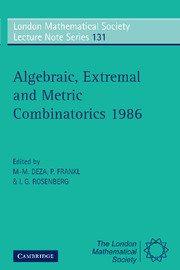Book contents
- Frontmatter
- Contents
- Introduction
- List of Talks
- Participants
- Some Recent Combinatorial Applications of Borsuk-Type Theorems
- On Extremal Finite Sets in the Sphere and Other Metric Spaces
- Metric and Geometric Properties of Sets of Permutations
- Infinite Geometric Groups and Sets
- Intersection and Containment Problems Without Size Restrictions
- Distance-Transitive Graphs of Valency k, 8 ≤ k ≤ 13
- Latin Square Determinants
- A Computer Search for a Projective Plane of Order 10
- Matroids, Algebraic and Non Algebraic
- Algebraic Properties of a General Convolution
- Quasi Groups, Association Schemes, and Laplace Operators on Almost Periodic Functions
- Geometric Methods in Group Theory
- Problem Section
Distance-Transitive Graphs of Valency k, 8 ≤ k ≤ 13
Published online by Cambridge University Press: 05 April 2013
- Frontmatter
- Contents
- Introduction
- List of Talks
- Participants
- Some Recent Combinatorial Applications of Borsuk-Type Theorems
- On Extremal Finite Sets in the Sphere and Other Metric Spaces
- Metric and Geometric Properties of Sets of Permutations
- Infinite Geometric Groups and Sets
- Intersection and Containment Problems Without Size Restrictions
- Distance-Transitive Graphs of Valency k, 8 ≤ k ≤ 13
- Latin Square Determinants
- A Computer Search for a Projective Plane of Order 10
- Matroids, Algebraic and Non Algebraic
- Algebraic Properties of a General Convolution
- Quasi Groups, Association Schemes, and Laplace Operators on Almost Periodic Functions
- Geometric Methods in Group Theory
- Problem Section
Summary
INTRODUCTION
In Faradẑev et al. (1936) an algorithm for enumeration of intersection arrays of distance–transitive graphs (d.t.g.) having given valency k is described. This algorithm was used in Faradẑev et al. (1936) for classification of the d.t.g.'s of valency k = 5, 6 and 7. This paper is a logical continuation of Faradẑev et al. (1986). Here we supply the algorithm with some new feasibility conditions. The new version of the algorithm enable us to classify the d.t.g.'s of valency up to 13.
All definitions and notations concerning d.t.g.'s can be found in Faradẑev et al. (1936) (see also Bannai & Ito (1984) and Brouwer et al. (1937)).
Let us summarise briefly the history of classification of d.t.g.'s having small valences. Chronologically the first result in the area is the classification of cubic d.t.g.'s (k=3), obtained by Biggs & Smith (1971). Their scheme of classification can be generalised on the case of an arbitrary valency k ≥ 3 and in general consists of the following four steps:
(1) to prove that the order of the vertex stabiliser in the automorphism group of d.t.g. having valency k is bounded by some value f = f(k);
(2) to bound the diameter of a d.t.g. having valency k by some value D = D(k);
(3) to enumerate all feasible intersection arrays for the given valency k;
(4) to construct all graphs with intersection arrays found on the step (3).
- Type
- Chapter
- Information
- Algebraic, Extremal and Metric Combinatorics 1986 , pp. 112 - 145Publisher: Cambridge University PressPrint publication year: 1988
- 1
- Cited by



